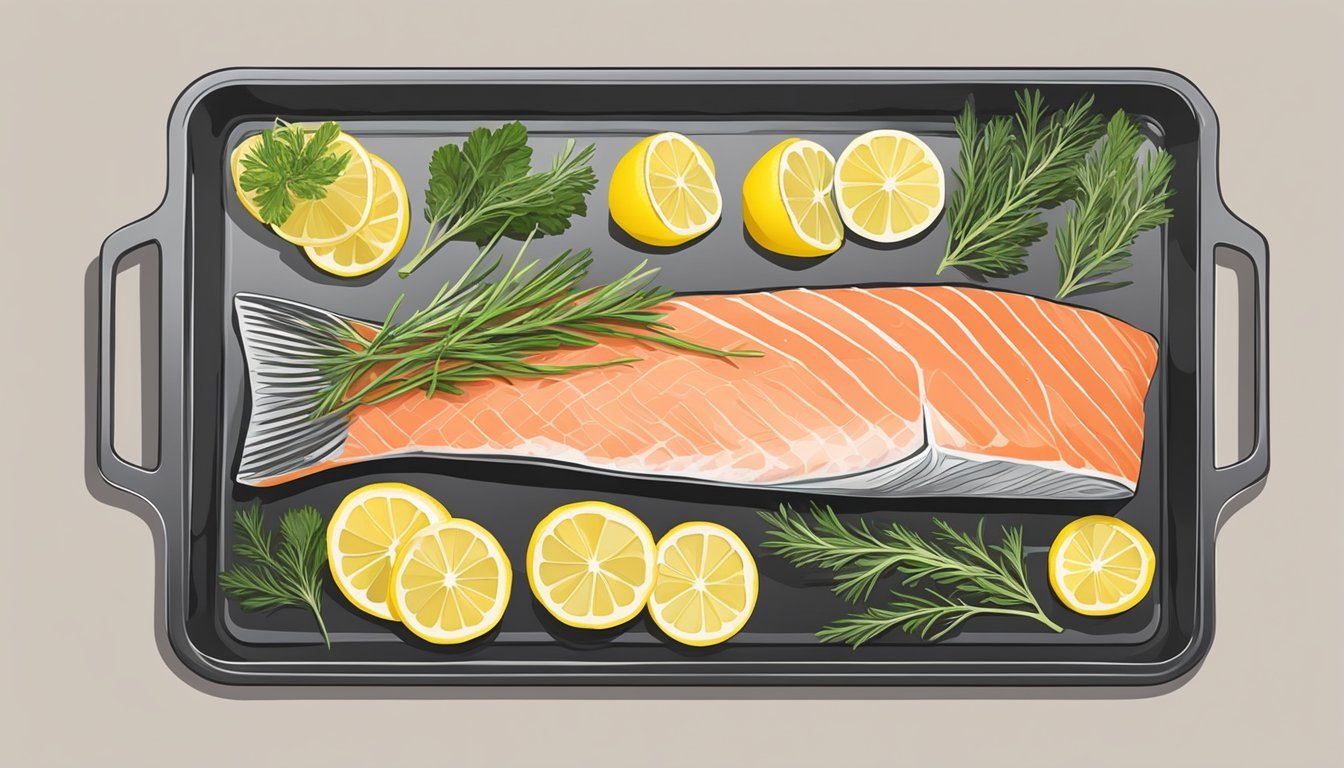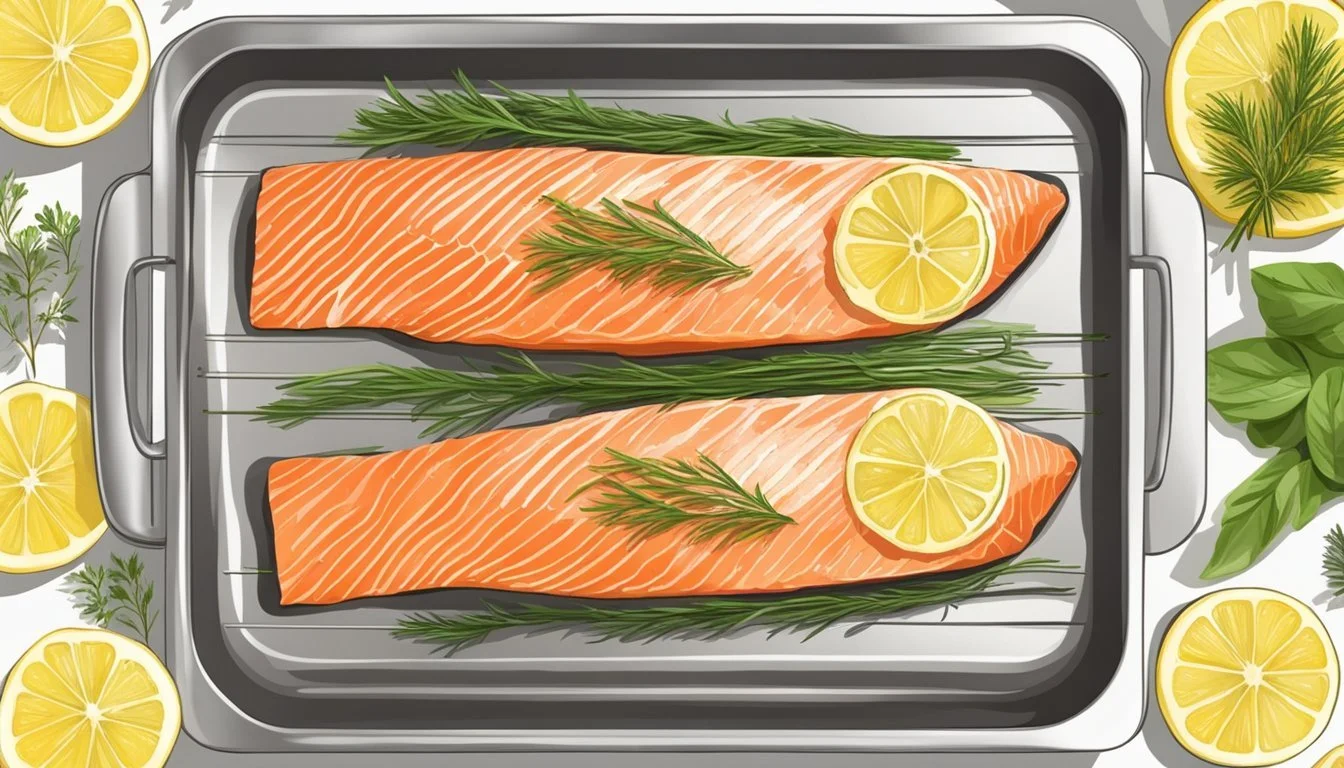How to Cook Salmon in the Oven
Perfectly Tender and Flavorful Results
Oven-baked salmon offers a delicious and healthy meal option that's surprisingly easy to prepare. With just a few simple steps, you can create a tender, flaky dish bursting with flavor. The key to perfectly baked salmon lies in preheating the oven to 425°F (218°C) and cooking the fillets for about 10 minutes per inch of thickness.
Choosing high-quality salmon is crucial for achieving the best results. Look for fresh, vibrant-colored fillets with a firm texture and no strong fishy odor. Before baking, season the salmon with salt, pepper, and your favorite herbs or spices to enhance its natural taste. For added moisture and flavor, consider brushing the fillets with olive oil or melted butter.
Experimenting with different marinades and toppings can elevate your oven-baked salmon to new heights. Try a honey-mustard glaze, a lemon-dill sauce, or a tangy teriyaki marinade to create diverse flavor profiles. Serve the baked salmon alongside roasted vegetables or a crisp salad for a complete and satisfying meal.
Essentials of Oven-Baked Salmon
Mastering oven-baked salmon requires attention to three key elements: selecting the right fish, proper preparation, and optimal oven settings. These factors significantly influence the taste, texture, and overall success of the dish.
Choice of Salmon
Fresh salmon fillets are the cornerstone of a delicious oven-baked meal. Sockeye salmon is prized for its rich flavor and vibrant color. When selecting salmon, look for firm flesh with a bright, uniform color. Avoid fillets with a strong fishy odor or dry appearance.
Wild-caught salmon often offers superior taste and nutritional benefits compared to farm-raised options. However, high-quality farmed salmon can also yield excellent results.
For consistent cooking, choose fillets of similar thickness. This ensures even heat distribution and prevents some pieces from overcooking while others remain undercooked.
Preparation for Baking
Proper preparation enhances the salmon's natural flavors and ensures a moist, flaky result. Begin by patting the fillets dry with paper towels to remove excess moisture.
Season the salmon generously with salt and pepper. Additional flavorings can include:
Fresh herbs (dill, parsley, thyme)
Minced garlic
Lemon slices
Olive oil or melted butter
A simple yet effective seasoning mix:
1 tsp kosher salt
1/2 tsp garlic powder
1/4 tsp paprika
Brush the salmon with olive oil or melted butter to keep it moist during cooking. For added flavor, place lemon slices or fresh herbs on top of the fillets before baking.
Oven Settings
Proper oven temperature and cooking time are crucial for perfectly baked salmon. Preheat the oven to 400°F (200°C) for most salmon recipes.
Line a baking sheet with aluminum foil or parchment paper for easy cleanup. Place the seasoned salmon fillets on the prepared sheet, skin-side down if applicable.
Cooking times vary based on the thickness of the fillets:
1-inch thick: 12-15 minutes
1.5-inch thick: 15-18 minutes
For a slightly crispy exterior, consider using the broiler for the last 1-2 minutes of cooking. The salmon is done when it flakes easily with a fork and reaches an internal temperature of 125-130°F (52-54°C) at its thickest part.
Cooking Techniques
Mastering salmon preparation involves understanding key techniques and variables. From baking methods to skin considerations, these approaches can significantly impact the final dish.
Baking the Salmon
Preheat the oven to 400°F (200°C) for optimal results. Line a baking sheet with aluminum foil or parchment paper for easy cleanup. Pat the salmon dry and season generously with salt and pepper.
Place the salmon on the prepared sheet. For added flavor, consider adding lemon slices or herbs. Bake for 12-15 minutes, depending on thickness.
To check doneness, use a fork to gently flake the thickest part. The salmon should be opaque and easily separate. An instant-read thermometer inserted into the thickest part should read 125°F to 130°F for medium-rare.
Advanced Methods
Air fryer salmon offers a quick alternative to oven baking. Preheat the air fryer to 400°F. Season the salmon and place it in the basket, skin-side down if applicable.
Cook for 7-9 minutes, adjusting time based on thickness. This method can yield crispy skin while maintaining a moist interior.
For a gentler approach, try slow-roasting at 275°F for about 30 minutes. This technique produces extremely tender, evenly cooked salmon.
Skin-On Versus Skinless
Cooking salmon with the skin on can enhance flavor and moisture retention. Place skin-side down on the baking sheet to create a barrier between the fish and the hot pan.
The skin becomes crispy and can be easily removed after cooking if desired. It also helps hold the fillet together during cooking.
Skinless fillets cook faster and may be preferred for certain recipes. They require more careful handling to prevent sticking and breaking. Brushing the pan with oil or using parchment paper can help.
Both options can produce delicious results. The choice often depends on personal preference and the specific recipe.
Enhancing Flavor and Texture
Salmon's mild flavor provides an excellent canvas for various seasonings and techniques to elevate its taste and texture. Proper seasoning and preparation can transform a simple fillet into a gourmet dish.
Use of Herbs and Spices
Fresh and dried herbs add aromatic complexity to salmon. Dill pairs exceptionally well, offering a bright, tangy flavor. Thyme brings a subtle earthiness that complements the fish's natural taste. For a bolder profile, try smoked paprika or a blend of onion powder and black pepper.
Lemon zest and juice brighten the dish, cutting through the richness of the salmon. A simple seasoning blend can include salt, pepper, garlic powder, and dried herbs for a quick and flavorful crust.
Experiment with different combinations to find your preferred flavor profile. Remember to apply herbs and spices evenly across the fillet for consistent taste in every bite.
Marinades and Glazes
Marinades infuse salmon with flavor while tenderizing the flesh. A basic marinade might combine soy sauce, honey, and lemon juice. For a tangy twist, add Dijon mustard to the mix.
Glazes caramelize during cooking, creating a flavorful exterior. A honey-soy glaze brings sweetness and umami, while a brown sugar and bourbon glaze offers rich, complex notes.
Apply marinades for 30 minutes to 2 hours before cooking. Brush glazes on during the last few minutes of baking to prevent burning. This technique ensures a moist interior and a perfectly lacquered exterior.
Serving and Presentation
Properly serving and presenting oven-baked salmon elevates the dining experience. The right accompaniments and plating techniques can transform a simple fillet into an impressive culinary creation.
Accompaniments
Rice makes an excellent base for salmon. Its mild flavor complements the fish without overpowering it. Steamed white rice or fragrant jasmine rice work well.
Vegetables add color and nutrition to the plate. Baked asparagus, green beans, or peas provide a fresh contrast. Roasted potatoes offer a hearty option that pairs nicely with salmon's richness.
For a lighter meal, serve the salmon atop an arugula salad. The peppery greens balance the fish's flavors. Couscous is another light option that absorbs the salmon's juices beautifully.
Don't forget a lemon wedge. A squeeze of citrus brightens the dish and cuts through the richness of the fish.
Plating Techniques
Start with a warm plate to keep the salmon at its ideal temperature. Place the fillet in the center, skin-side down if applicable.
Arrange accompaniments artfully around the salmon. Create height by stacking vegetables or nestling the fish on a bed of rice or couscous.
Use a fork to gently separate the salmon's flaky layers before serving. This showcases its tender texture and makes it easier to eat.
Drizzle any sauce or glaze over the fish in a zigzag pattern for visual appeal. Garnish with fresh herbs like dill or parsley for a pop of color.
After-Cooking Tips
Proper handling of salmon after cooking is crucial for maintaining its quality and flavor. Follow these tips to ensure your salmon remains moist and delicious, whether serving immediately or storing for later.
Resting and Serving
Allow the salmon to rest for 3-5 minutes after removing it from the oven. This helps the juices redistribute, keeping the fish moist.
Use a spatula to gently transfer the salmon to serving plates. Be careful not to break the delicate flesh.
Garnish with fresh herbs or lemon wedges for added flavor and visual appeal.
Serve the salmon hot with your choice of sides. Popular options include roasted vegetables, rice pilaf, or a crisp salad.
For a beautiful presentation, consider removing the skin before plating if you cooked the salmon with the skin on.
Storing Leftovers
Refrigerate leftover salmon within 2 hours of cooking to prevent bacterial growth.
Place the cooled salmon in an airtight container. Plastic wrap or aluminum foil can also work if sealed tightly.
Store in the refrigerator for up to 3 days. Consume chilled or gently reheat.
For longer storage, freeze salmon in an airtight container or freezer bag. It will keep for up to 3 months.
Thaw frozen salmon in the refrigerator overnight before reheating or using in cold dishes.
To reheat, warm gently in a low oven or microwave to avoid drying out the fish.
Recipe Variations and Ideas
Salmon's versatility allows for numerous delicious preparations. Quick weeknight meals and creative toppings can elevate this nutritious fish to new heights.
Quick Weeknight Dinners
For busy evenings, try a simple honey-garlic glaze. Mix honey, minced garlic, and soy sauce. Brush on salmon fillets and bake at 400°F for 12-15 minutes.
A lemon-dill marinade offers bright flavors. Combine lemon juice, chopped dill, and olive oil. Coat salmon and refrigerate for 30 minutes before baking.
Cajun-spiced salmon provides a zesty kick. Mix paprika, cayenne, garlic powder, and dried herbs. Rub on salmon and bake until flaky.
For an Asian-inspired dish, whisk soy sauce, rice vinegar, and brown sugar. Brush on salmon and bake, finishing with a sprinkle of sesame seeds.
Creative Toppings
Mango salsa adds a tropical twist. Dice mango, red onion, and cilantro. Mix with lime juice and a pinch of salt. Spoon over baked salmon.
Create a crunchy pecan crust. Combine chopped pecans, breadcrumbs, and herbs. Press onto salmon before baking for a delightful texture.
Try a Mediterranean topping with diced tomatoes, olives, and feta cheese. Sprinkle on salmon during the last few minutes of baking.
For a creamy finish, mix Greek yogurt with lemon zest and dill. Dollop on hot salmon just before serving.
Pesto lovers can spread a thin layer of basil pesto on salmon before baking. This adds vibrant color and flavor to the dish.
Essential Tips and Tricks
Mastering salmon in the oven requires attention to detail and proper technique. These tips will help you achieve perfectly cooked, flavorful results every time.
Avoiding Common Mistakes
Pat salmon dry with paper towels before seasoning to ensure crispy skin. Use cooking spray on the baking sheet to prevent sticking. Place salmon skin-side down for even cooking. Avoid overcooking by checking for doneness early. Insert a fork into the thickest part - it should flake easily but still be moist inside.
Preheat the oven to 400°F (200°C) for consistent results. Line the baking sheet with parchment paper for easy cleanup. Season generously with salt and pepper just before cooking. For added flavor, place lemon slices or herbs on top of the fillets.
Mastering Doneness and Texture
Cook salmon for 12-15 minutes per inch of thickness. Thicker fillets may need up to 20 minutes. For medium doneness, the internal temperature should reach 125°F (52°C). Let rest for 5 minutes after cooking to allow juices to redistribute.
To achieve moist salmon, avoid overcooking. The fish will continue to cook slightly after removal from the oven. For a crispy exterior, broil for 1-2 minutes at the end of cooking time. Experiment with different seasonings and marinades to enhance flavor.
Use a meat thermometer for precise doneness. Remove salmon when it reaches 120°F (49°C) for medium-rare or 130°F (54°C) for medium. The color should be opaque pink throughout when fully cooked.




